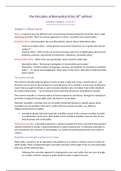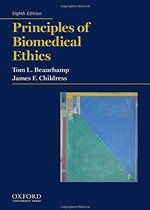The Principles of Biomedical Ethics (8th edition)
Summary Chapters: 1/4/5/6/7
annotations are not derived from the book
Chapter 1: Moral norms
Ethics: is a general term for different ways of examining and interpreting the moral life, what is right
and wrong and why? There are several approaches to ethics: normative and nonnormative.
Normative ethics: what should be the case (theoretical), what in theory hold ethical value.
- General normative ethics: “which general moral norms should we use to guide and evaluate
conduct?”-
- Practical ethics: “refers to the use of moral concepts and norms in deliberations about moral
problems, practices, and policies in professions, institutions, and public policy”
Nonnormative ethics: What is the case (practically), what in practice holds value
- Descriptive ethics: “the factual investigation of moral beliefs and conduct”
- Metaethics: “involves analysis of language, concepts, and methods of reasoning in normative
ethics.” – it’s about moral judgement, where does it come from, what does it entail and what
does it mean?
The common morality
The common morality holds the general norms of what is right and wrong, a shared idea of.. and
therefore can be seen as the standard for moral behaviour (if we all think a certain type of behaviour
is just, than we ought to behave in such a manner). Besides rules of conduct it also holds standards
for certain traits/values. – “set of universal norms shared by all persons committed to morality”
The common morality is a shared product of human experience and history, through the standards it
prescribes it supports human rights and is the basis for moral ideals.
Particular moralities: moralities that are not widely shared but belong to a specific group, these
moralities are only justified if they don’t conflict with the common morality. e.g.; different
religions/professional moralities
Sometimes people take their particular moralities as part of the common morality, and take
an authoritative moral voice. Their beliefs can be morally acceptable, however they do not
bind all groups and communities.
Professional morality: a (learned) profession is a group of people who have a job where they perform
relevant functions to society. A learned profession is when someone had “an extensive education in
arts, humanities, law, sciences, or technologies. E.g. health care professionals whom have codes of
conduct.
Regulation and oversight of professional conduct
Public policy, contains a set of regulations and guidelines as a means to endorse ways of conduct by
public bodies. Policy is shaped through a normative structure (what ought to be), by moral principles
and rules, and by empirical data.
- Following the normative approach in shaping policy one must realise that one can not judge
on a matter of what is (un)just in policy based on what is ought to be just.
, o “the judgement that an act is morally acceptable does not imply that the law should
permit it”, nor does the judgement that an act is morally unacceptable imply a law
should prohibit – e.g. when you prohibit abortion, women will seek illegal and unsafe
ways to abort.; externalities.
Moral dilemmas
Moral dilemmas are situations where two contradictory actions are demanded which exclude each
other, meaning someone can’t perform all required actions (e.g. you can’t euthanise and not
euthanise someone at the same time). There are two forms of moral dilemmas:
- There is evidence for arguments stating an act is morally right and morally wrong, the
evidence/strength of arguments on both sides is incomplete.
- The agent believes he/she is obligated to perform conflicting actions that exclude each other
based on moral grounds.
In the book the authors state that in case of a moral dilemma, you should choose for the one you’re
overriding. So where it not for the conflict, what would we have done/would we be obliged to do?
Moral principles chapters 4-7
The common morality as starting point, four moral principles have been derived (respect for
autonomy/nonmaleficence/beneficence/justice). These moral principles form a framework to reflect
on moral dilemmas within biomedical ethics.
Rules
Just like the moral principles, rules are norms of obligation – norms of how something ought to be.
However rules are more detailed than the moral principles.
- Substantive rules: rules that explicate the principles.
- Authority rules: rules with regards to whom is allowed to make or not make decisions or
perform actions.
- Procedural rules: when there are no substantive rules, or authority rules are incomplete we
use the procedural rules. Where procedures people should follow are made.
Rules are, in principle, dependent on specification. Without specification, it’s a general principle, and
a general principle is not enough to capture the complexity of moral phenomena. Specification is
concerned with the scope/range of different moral norms. The relative weight and strengths of these
moral norms, and therefore which norm overrides another, has to do with “balancing”.
- Public policy vs. particular cases
Six conditions for balancing that “help reduce intuition, partiality, and arbitrariness”
1. “Good reasons are offered to act on the overriding norm rather than the infringed norm”
2. “The moral objective justifying the infringement has a realistic prospect of achievement”
3. “No morally preferable alternative actions are available”
4. “The lowest level of infringement, commensurate with achieving the primary goal of the
nnmaction, has been selected”
5. “All negative effects of the infringement have been minimized”
6. “All affected parties have been treated impartially”





